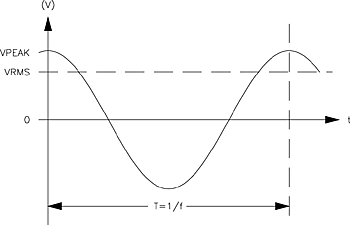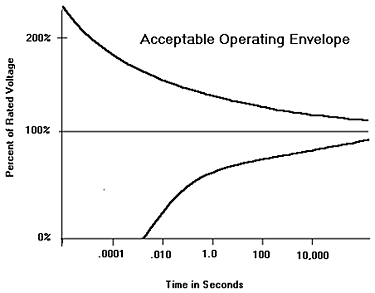
The “Perfect” Sine Wave
In general, the ideal voltage source for most equipment is a pure 60-Hz sinusoidal waveform of the correct magnitude as shown in Figure 1. As we’ve described in previous columns, most electrical equipment is designed to operate satisfactorily from a sine wave of voltage having an RMS magnitude within ± 10% of its rating.
The extent of variation from this ideal voltage source that can be tolerated, depending on the duration of the event and disturbances, are often classified by how much and for how long the voltage deviates from an ideal sine wave. In general, the shorter the duration, the greater the magnitude of deviation that can be tolerated (Figure 2).

Power Quality Vocabulary
Power quality discussions are often complicated by the variety of terms used to describe disturbances, which are not always consistently applied. We will use the following definitions, which are consistent with those given in IEEE Standard 1100-1992, “Recommended Practice for Powering and Grounding Sensitive Electronic Equipment.”
- An interruption is a complete loss of voltage for a period of 30 cycles or longer.
- A sag is a reduction in voltage magnitude lasting from several cycles to several minutes. Common causes include starting large motors and power system faults.
- A surge is an increase in voltage magnitude lasting from several cycles to several minutes. These can be caused by regeneration from large loads such as traction motors, by generator voltage regulator problems, or utility problems.
- Impulses, also frequently called “spikes,” are extremely short-duration rapid changes in voltage magnitude, typically on the order of 1 to 100 microseconds in length. They result from discharges of energy into the system from sources such as lightning, power capacitor switching, etc.
- Noise is a high-frequency signal, usually of low relative magnitude, that is superimposed on the ac waveform. High-frequency noise can be introduced into the power system by many types of equipment, including vfd’s and computer power supplies, and can be caused or intensified by improper grounding.
- Harmonics are components of ac current or voltage that have frequencies that are integer multiples of the fundamental 60 cycle line frequency. These generally result from discontinuous current drawn by electronic equipment such as computers and vfd’s.
- Waveform distortion is deviation from the ideal sine wave shape that repeats itself from cycle to cycle. The most common effect is distortion of the voltage waveform caused by voltage drop associated with the harmonic current drawn by electronic equipment.
Cause and Effect
A wide variety of power quality problems with diverse causes can originate either inside or outside the facility. Their effects on sensitive equipment can include data processing errors, misoperation, and premature failure of electronic components. The primary concern for hvacr engineers should be properly protecting sensitive equipment from disturbances, whatever the source, and minimizing disturbances created by equipment that you specify.Next month, we’ll take a close look at the impact of vfd’s on the building electrical system, tips on determining whether power quality problems are likely, and describe how to address this issue in your drive spec.

